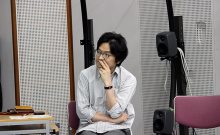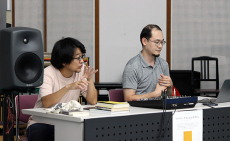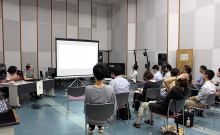The 3rd Design Fundamentals Seminar: Design as Critique
Rather than criticizing design, reality should be criticized through design. How can that type of design be made possible? As long as design is a response to reality, it encompasses a sense of interpretation and assigns value to the status quo. For that reason, design is a tool to critique reality, through “things” rather than words. We heard from Shintaro Miyazaki of the University of Applied Sciences and Arts Northwestern Switzerland as he guided us through cutting edge ideas in design across the German-speaking world.
Lecturer
Shintaro Miyazaki
Born in Berlin in 1980, Shintaro Miyazaki is a researcher at University of Applied Sciences and Arts Northwestern Switzerland. He is also the curator of the Institute of Experimental Design and Media Culture’s Critical Media Lab (IXDM). Investigating into fields such as cybernetics, ecosystem thinking, counter culture, and Marxism, he is involved with projects [IXDM] that deepen the understanding of how these “problem systems” relate to design, media, and art. He received his doctorate degree in Media Studies from the Humboldt University of Berlin in 2012.
Date
Mon. July 9, 2018, 3:00-5:00 pm
Venue
Kyushu University Ohashi Campus, Acoustic Recording Studio
Review
Mr. Miyazaki defines design as the act of organizing various elements around him and freeing himself. Beyond that, he defines critique by going all the way back to the two Ancient Greek words from which it derives: ‘kriticos,’ an adjective meaning to accurately judge, and ‘krinion,’ a verb meaning to distinguish, and saying that it is to divide at a proper moment, to differentiate something at a critical moment.
He began with defining the word by going all the way back to Ancient Greek, and I thought this way of thinking was quintessential of someone from a German-speaking country. Design and critique – if we were to combine these two concepts, I believe design as critique would hold the following meaning.
When I feel that my way of life is inconvenient, at a certain decisive moment in time, I will make room for the possibility of something different and re-establish the potential for my own freedom.
Mr. Miyazaki says that with the advancement of technology not only expands the potential of people’s freedom, but that it in fact is re-modeling humans. The fact that humans are being re-modeled due to the advancement of technology does not necessarily mean the re-establishment of human freedom. If that is the case, it is necessary to redefine what it is and make accurate decisions about technology.
Design as critique, as far as criticism toward neoliberalism or colonialism, feminism, Marxism, and Science and Technology Studies (STS) goes, makes us living in the real world reflect on ourselves and do something to expand our freedom.
Moreover, Mr. Miyazaki developed a theoretical background to design by bringing up three people he himself has been influenced by as a researcher: Hans-Joerg Rheinberger known for his study of epistemology, media theorist Friedrich Kittler, and design studies specialist Claudia Mareis. As a practical example of design, he also brought up “speculative design” which Dunne & Raby advocate.
Where is the point in which critique of modern art and design as critique diverge? Are normal functional designs and designs as critique completely opposite? With these and other questions being raised, together with Mr. Miyazaki’s work, we had a very fruitful discussion.
(Koga Toru)


(left) Kazuhiro Jo

